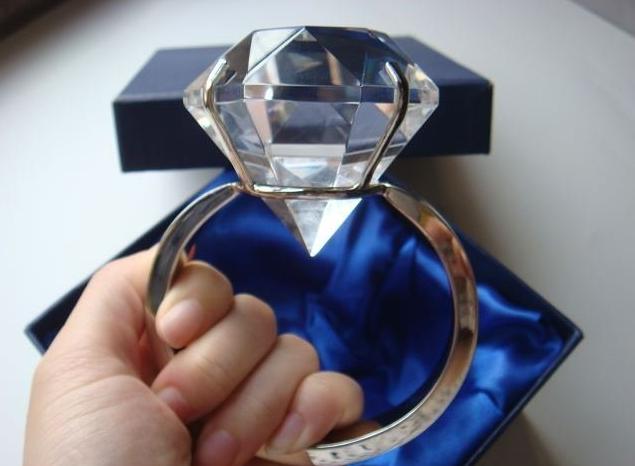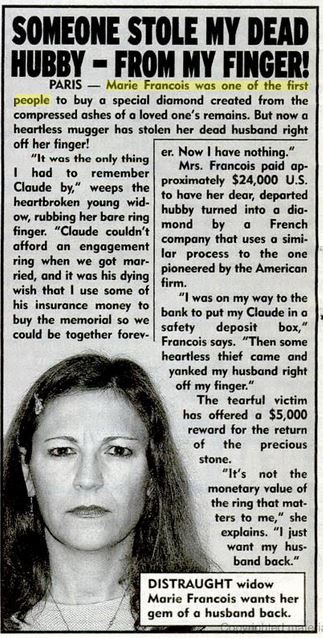The Man Who Wore His Wife August 17, 2017
Author: Beach Combing | in : Modern , trackbackYou could fill a large book with anecdotes, urban legends and folk tales about rings. Most fall fairly effortlessly into certain categories: lost ring found; ring makes wearer invisible; ring cut from corpse’s finger… However, here is one of its kind: husband wears wife. Beach has had a five day holiday and this was a welcome return gift.
A Russian nobleman, extremely wealthy and very reserved and melancholy, has appeared of late in the best circles [in Paris], to which he has had the most distinguished introducers. The Russian became remarkable for wearing a ring of colossal proportions, covering nearly the entire finger, and of singular appearance, the centre being composed of a substance resembling jet, which was set in gold. No one ventured to ask the character of the ring or the cause of its being worn, and placing the wearer, a studiously quiet man, in the light of being an eccentric individual. A lady, however, who was piqued to know something about the matter, at last mustered the requisite courage, and said, ‘Monsieur, every one is very much struck with the singular character of the ring you wear, and I for one should be delighted to know its origin.’
Cue awkward silence.
The Russian made a nervous twitch with his hand, as though he would like to hide it, while he replied, ‘Madam, the ring is not a jewel, as you suppose, but a tomb.’ The curious gathered round while he continued: ‘ This jet substance is the body of my wife; she had horror of a tomb in Russia; she was Italian [!]. I promised her that I would guard her day and night during my life, and she died calmly in the confidence which she reposed in my word, which had never been broken. I took the body of my wife to Germany, where the most able chemist of the day promised to reduce it, by powerful dissolvents and by great compression, to a size which would enable me to wear it as a souvenir. For eight days he laboured almost constantly in my presence, and I saw the dear remains gradually dissolve and intensify till the residue was the compact mass which you see in the ring, which is my dear wife, who, as I promised, I will never quit day or night during my life.’
What did they say? The writer – this story ran like clap through the British press in November 1864 – doesn’t tell us. Any parallels to this creepy tale: drbeachcombing AT yahoo DOT Com
Beach’s family was in the Ramblas in Barcelona yesterday: our thoughts go out to the victims.
Lots of emails on this…
Andrew Z and lots of others wrote in, 29 Aug 2017: The story of “The Man Who Wore His Wife” lives again as a modern fad. There are a number of companies who offer the service of making diamonds out of carbon taken from the remains of your loved ones, for example: http://www.heart-in-diamond.co.uk/ I should make clear that this is an example not an endorsement. As they would say on the BBC, other corpse carbon compressors are available.
Brian C sent in this fictious news report, 29 Aug 2017:
New York Post | 2 March 2003
THE FAMILY JEWELS
By SARAH GILBERT
She sparkled in life, and now she sparkles in death.
When Valerie Sefton died last year, her father decided to make a lasting memorial for her – by having her remains turned into diamonds.
“It’s tremendous,” said her father, Bill Sefton, 51.
“I can look at the ring, and it gives me a good feeling. I can’t say that about looking at the ashes – that’s a very hard thing.”
Valerie, who died Sept. 10, is the first person whose family is known to have paid to have their loved one’s remains turned into diamonds, giving them precious keepsakes to remember her by.
LifeGem, a Chicago-based company, turns the cremated remains of people and pets into diamonds by extracting the carbon in their ashes, then heating and pressing it at extreme temperatures – similar to the natural process that turns carbon into diamonds.
Sefton, a Scottsdale, Ariz., businessman, heard about LifeGem on television.
He and his wife, Becky Sefton, knew right away it would be a perfect way to remember Valerie.
“Her personality was very sparkling, full of life,” said her proud father.
His daughter was diagnosed with Hodgkin’s disease when she was 22, having just graduated from college. She was looking forward to a career in early-childhood development.
She struggled with the disease for five years, never giving up hope, said her father, who likened her strength to that of the diamond.
“If you had talked to Valerie through this period of time, if you didn’t know she was sick, you would never have guessed it,” said Sefton. “Her attitude was incredible.”
He wears a ring with a half-carat diamond, costing around $5,000.
It is set in a band of white and yellow gold, along with six smaller, regular diamonds, which he wears on the ring finger of his left hand around the clock.
The family had five additional stones made, costing around $2,300 each.
“My wife and I have already got our rings done,” he said.
“Valerie’s mother, my ex-wife, Christine, will also be doing a ring, and Valerie’s sister, Tracey, will have a necklace, I believe.”
There is an extra diamond for Bill’s sister, Kathy Rinna, and one for Valerie’s niece, 3-year-old Tracey McElmeel.
“She will be given that sometime later – probably when she graduates from high school,” Bill said. “Then she can decide what she wants to do with it.”
David O, 29 Aug 2017: I’m sure you’re about to be inundated, but google “cremation diamonds” or “memorial diamonds”.
It’s interesting that the “stone” in the ring in your story was “a substance resembling jet”. It’s probably because jet is associated with mourning, but… a body is basically oxygen, carbon, hydrogen, nitrogen, calcium, and phosphorus. Burn off everything else and you’re going to be left with about 15 kilos of carbon. It’s not completely outside the bounds of possibility that a Victorian (or earlier?) chemist could turn a body into, say, graphite:
I’m reminded of a few things:
* Victorian hair wreaths or mourning rings, and anthropodermic bibliopegy, both of which transform the deceased into a keepsake.
* About a decade ago a couple had weddings rings made from each others’ bone (cultured, but I think they had to yank wisdom teeth to get the cells).
* Very loosely, a piece of fiction – London Bone by Michael Moorcock. You can hear it being read (rather well, I think) at (jump to 8:30).




